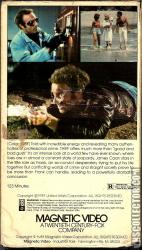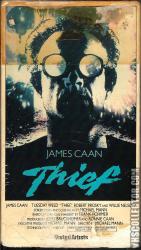Thief
Catalog Number
4550-30
-
Primary Distributor (If not listed, select "OTHER")
Catalog Number
4550-30
Primary Distributor (If not listed, select "OTHER")
Release Year
Country
N/A (NTSC)
N/A | N/A | N/A
N/A | N/A
Thief (1981)
Additional Information
Additional Information
Ronnie Caan served as the film's co-producer. James Caan's emotional several-minute monologue with Weld in a coffee shop is often cited as the film's high point, and Caan has long considered the scene his favorite of his career.[3]
The actor liked the movie although he found the part challenging to play. "I like to be emotionally available but this guy is available to nothing."[4]
Being Michael Mann's feature film directorial debut, Thief showcases many of the cinematic techniques that would be his trademarks in the years to come. Chief among these is the cinematography, utilizing light and shadow to give the proceedings, especially those taking place in the darkness of night, a sense of danger. The film also earns plaudits for its meticulous attention to detail: the tools and techniques of the trade, right down to the oxy lance used to penetrate a safe, are authentic, the result of Mann's decision to hire real-life thieves to serve as technical advisers.
Thief marks the first film appearance of veteran actors Dennis Farina, William Petersen, James Belushi and Robert Prosky. At the time a Chicago police officer, Farina appears as a henchman. Ironically, John Santucci, who plays the role of corrupt cop Urizzi, was a recently paroled thief and acted as a technical adviser on Thief. In 1986, Farina and Santucci both were cast in Michael Mann's TV series Crime Story, Farina as a Chicago police lieutenant and Santucci as a jewel thief. Petersen, who later would star in the Mann film Manhunter, appears briefly as a bouncer at a club.
Originally titled Violent Streets, the film debuted at the 34th Cannes Film Festival.[5] It went on to open in theaters in the United States on March 27, 1981, earning a modest $4.3 million. While not a financial success in its initial release, the film has become a reference point in Mann's career, especially with the release of his crime epic, Heat, with which this movie has many similarities.
The still of Frank holding a gun as he takes Attaglia hostage was used for one of the movie's posters.[6]
Near the end of the film, Frank destroys his house. The film company built a false front onto a real house and attempted to destroy it with explosives. The explosions severely damaged the real house, however, leading to its demolition.
The actor liked the movie although he found the part challenging to play. "I like to be emotionally available but this guy is available to nothing."[4]
Being Michael Mann's feature film directorial debut, Thief showcases many of the cinematic techniques that would be his trademarks in the years to come. Chief among these is the cinematography, utilizing light and shadow to give the proceedings, especially those taking place in the darkness of night, a sense of danger. The film also earns plaudits for its meticulous attention to detail: the tools and techniques of the trade, right down to the oxy lance used to penetrate a safe, are authentic, the result of Mann's decision to hire real-life thieves to serve as technical advisers.
Thief marks the first film appearance of veteran actors Dennis Farina, William Petersen, James Belushi and Robert Prosky. At the time a Chicago police officer, Farina appears as a henchman. Ironically, John Santucci, who plays the role of corrupt cop Urizzi, was a recently paroled thief and acted as a technical adviser on Thief. In 1986, Farina and Santucci both were cast in Michael Mann's TV series Crime Story, Farina as a Chicago police lieutenant and Santucci as a jewel thief. Petersen, who later would star in the Mann film Manhunter, appears briefly as a bouncer at a club.
Originally titled Violent Streets, the film debuted at the 34th Cannes Film Festival.[5] It went on to open in theaters in the United States on March 27, 1981, earning a modest $4.3 million. While not a financial success in its initial release, the film has become a reference point in Mann's career, especially with the release of his crime epic, Heat, with which this movie has many similarities.
The still of Frank holding a gun as he takes Attaglia hostage was used for one of the movie's posters.[6]
Near the end of the film, Frank destroys his house. The film company built a false front onto a real house and attempted to destroy it with explosives. The explosions severely damaged the real house, however, leading to its demolition.
Related Releases3
Catalog Number
M201305
Primary Distributor (If not listed, select "OTHER")
Thief (1981)
Release Year
Catalog Number
M201305
Primary Distributor (If not listed, select "OTHER")
Catalog Number
M201305
Catalog Number
4550-20
Primary Distributor (If not listed, select "OTHER")
Thief (1981)
Release Year
Catalog Number
4550-20
Primary Distributor (If not listed, select "OTHER")
Catalog Number
4550-20
Catalog Number
M205114
Primary Distributor (If not listed, select "OTHER")
Thief (1981)
Release Year
Catalog Number
M205114
Primary Distributor (If not listed, select "OTHER")
Catalog Number
M205114














Comments0
Login / Register to post comments